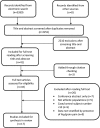Which factors differentiate athletes with hip/groin pain from those without? A systematic review with meta-analysis
- PMID: 26031646
- PMCID: PMC4484362
- DOI: 10.1136/bjsports-2015-094602
Which factors differentiate athletes with hip/groin pain from those without? A systematic review with meta-analysis
Abstract
Background: Hip and groin injuries are common in many sports. Understanding the factors differentiating athletes with hip/groin pain from those without these injuries could facilitate management and prevention.
Objective: Conduct a systematic review and meta-analysis of the literature on factors differentiating athletes with and without hip/groin pain.
Methods: The review was registered as PROSPERO CRD42014007416 and a comprehensive, systematic search was conducted in June 2014. Inclusion criteria were: cross-sectional, cohort or case-control study designs of n>10 that examined outcome measures differentiating athletes with and without hip/groin pain. Two authors independently screened search results, assessed study quality, and performed data extraction. Methodological heterogeneity was determined and data pooled for meta-analysis when appropriate. A best evidence synthesis was performed on the remaining outcome measures.
Results: Of 2251 titles identified, 17 articles were included of which 10 were high quality. Sixty two different outcome measures were examined, 8 underwent meta-analysis. Pooled data showed strong evidence that athletes with hip/groin pain demonstrated: pain and lower strength on the adductor squeeze test, reduced range of motion in hip internal rotation and bent knee fall out; however, hip external rotation range was equivalent to controls. Strong evidence was found that lower patient-reported outcome (PRO) scores, altered trunk muscle function, and moderate evidence of bone oedema and secondary cleft sign were associated with hip/groin pain.
Conclusions: PROs, pain and reduced strength on the adductor squeeze test, reduced range of motion in internal rotation and bent knee fall out are the outcome measures that best differentiate athletes with hip/groin pain from those without this pain.
Keywords: Athlete; Groin; Hip; Injuries; Sports.
Published by the BMJ Publishing Group Limited. For permission to use (where not already granted under a licence) please go to http://group.bmj.com/group/rights-licensing/permissions.
Figures










References
Publication types
MeSH terms
LinkOut - more resources
Full Text Sources
Other Literature Sources
Medical
Miscellaneous
